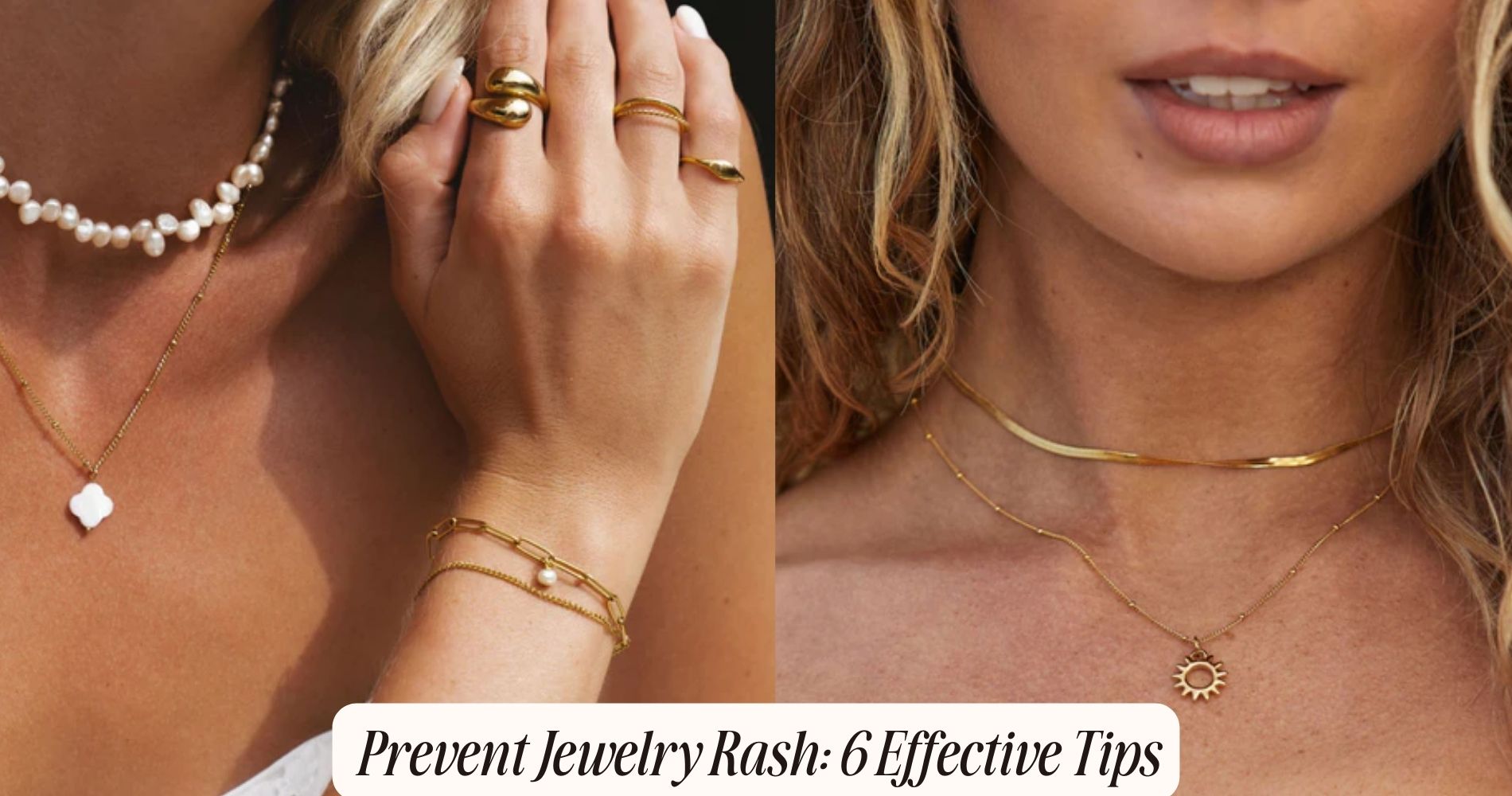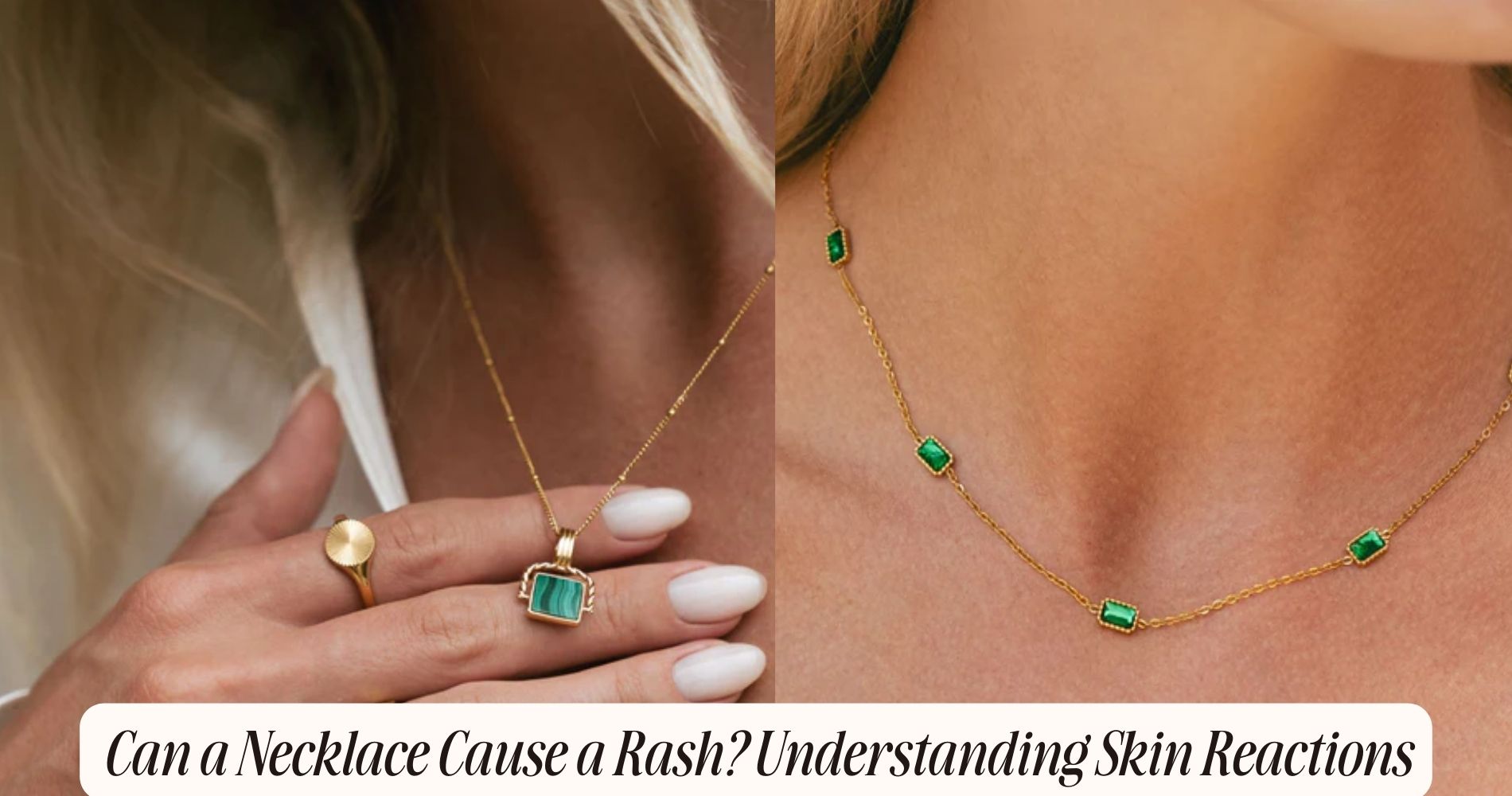
Prevent Jewelry Rash: 6 Effective Tips
Choose Hypoallergenic Materials
When selecting jewelry, prioritize hypoallergenic materials to minimize the risk of skin irritation. If you have a history of nickel allergies or metal sensitivity, choosing the right materials becomes essential. Nickel is a common allergen found in many types of jewelry, and exposure can lead to contact dermatitis, characterized by redness, itching, and swelling.
Opt for jewelry crafted from materials such as surgical-grade stainless steel, titanium, or platinum. These metals are less likely to cause adverse reactions. Additionally, consider pieces made from gold or sterling silver with a higher purity level, as these typically contain less nickel.
Avoid costume jewelry that often contains mixed metals, as these can trigger allergic responses. Even if a piece looks appealing, if it contains nickel or other irritants, it mightn't be worth the discomfort.
Read product descriptions carefully and look for labels indicating that items are nickel-free or hypoallergenic. By being vigilant about the materials used in your jewelry, you can enjoy your accessories without the fear of developing a rash or other allergic reactions.
Prioritizing hypoallergenic options is a simple yet effective way to protect your skin.
Keep Jewelry Clean
Maintaining clean jewelry is essential to prevent skin irritation and prolong the life of your pieces. Regular cleaning removes dirt, oil, and sweat that build up over time, which can lead to rashes and discoloration.
Implement effective jewelry cleaning methods tailored to the materials of your jewelry. For instance, use a soft cloth for gold and silver, while a mild soap solution is suitable for most gemstones. Avoid harsh chemicals that can damage delicate settings.
Incorporate jewelry maintenance tips into your routine. Clean your jewelry at least once a month, or more frequently if you wear it daily. Inspect each piece for signs of wear or damage during cleaning; catching issues early can prevent further deterioration.
For items that require special care, consider professional cleaning services. These experts can handle intricate designs and materials that may be challenging for you to clean safely.
Finally, store your jewelry properly after cleaning. Use individual pouches or a soft-lined box to prevent scratches and tangling.
Avoid Excess Moisture
To prevent jewelry rash, it's essential to avoid excess moisture around your skin.
Opt for breathable materials that allow air circulation, reducing sweat buildup.
Additionally, always keep your jewelry dry, especially after activities that may cause you to perspire.
Choose Breathable Materials
Choosing breathable materials for your jewelry can greatly reduce moisture buildup, which is a common trigger for skin irritation.
Breathable fabrics, such as cotton, silk, or certain synthetic blends, allow air circulation and help wick away sweat. This is particularly important during warmer months or when engaging in physical activities, as elevated moisture levels can exacerbate skin sensitivities.
When selecting jewelry, consider how the fit impacts breathability. Tight-fitting pieces can trap moisture against your skin, increasing the likelihood of irritation.
Opt for designs that allow for some space between the jewelry and your skin, promoting airflow. For instance, earrings with open designs or necklaces with adjustable lengths can help maintain a comfortable fit while reducing moisture retention.
Additionally, take note of any metal components. Some metals, like stainless steel or titanium, are less likely to cause allergic reactions and may be more breathable than others.
By prioritizing breathable materials and the right jewelry fit, you can effectively minimize the risk of rashes and guarantee a more comfortable wearing experience.
This proactive approach is key to enjoying your jewelry without the discomfort of skin irritation.
Keep Jewelry Dry
Keeping your jewelry dry is essential to preventing skin irritation, as excess moisture can create an environment conducive to rashes and discomfort. To achieve this, adopt effective jewelry storage practices. Store your pieces in a cool, dry place, avoiding areas with high humidity, like bathrooms. Use airtight containers or moisture-absorbing packets to mitigate humidity exposure.
Implementing proper drying techniques is also vital. After washing your hands or swimming, remove your jewelry to prevent moisture buildup. If your jewelry gets wet, gently pat it dry with a soft cloth immediately. For metal pieces, consider using silica gel packets to absorb any residual moisture.
Additionally, be mindful of wearing jewelry during activities that may cause excessive sweating, such as exercise. It's best to remove your jewelry before engaging in these activities to reduce moisture contact.
Regularly check your jewelry for signs of tarnish or moisture damage, and clean it appropriately to maintain its integrity.
Rotate Your Accessories
To prevent jewelry rash, it's crucial to vary your jewelry choices.
By limiting the continuous wear time of each piece, you reduce the risk of skin irritation.
Consider rotating your accessories regularly to promote skin health and comfort.
Vary Your Jewelry Choices
Rotating your accessories can greatly reduce the risk of developing a jewelry rash by allowing your skin to breathe and recover from irritation. By varying your jewelry choices, you minimize prolonged exposure to metals and materials that may cause allergic reactions or skin sensitivity. Different jewelry styles can offer both aesthetic appeal and functional benefits, ensuring your skin remains healthy while you express your fashion sense.
Consider incorporating a range of materials, such as gold, silver, and hypoallergenic options, into your collection. This approach not only keeps your skin safe but also aligns with current fashion trends, allowing for a versatile wardrobe. By mixing and matching your accessories, you can adapt to different occasions and moods while reducing the likelihood of irritation.
Be mindful of how certain materials interact with your skin. For example, stainless steel and titanium are often better tolerated than other metals. Always observe how your skin reacts to various jewelry styles, and make adjustments as needed. By consciously varying your jewelry choices, you'll maintain both your style and skin health, creating a balanced approach to accessorizing.
Limit Continuous Wear Time
Limiting the continuous wear time of your jewelry helps prevent irritation and allows your skin to recover from any potential reactions. By rotating your accessories, you can minimize the cumulative wear duration of each piece, reducing the likelihood of skin reactions. Continuous exposure to metals and other materials can lead to allergic responses or dermatitis, especially if your skin has pre-existing sensitivities.
To effectively manage wear duration, consider establishing a schedule for your jewelry. For instance, you might choose to wear earrings for one day and switch to a different pair the next. This practice gives your skin a break, allowing it to breathe and recover. Additionally, take off your jewelry during activities that may involve sweating or exposure to irritants, such as exercising or applying lotions.
Pay attention to how your skin responds after wearing specific items. If you notice redness, itching, or any discomfort, it may be time to extend the break between wears. Ultimately, rotating your accessories not only enhances your style but also promotes healthier skin. Prioritizing wear duration is a simple yet effective strategy in preventing jewelry rash.
Apply Barrier Creams
Applying barrier creams can effectively reduce the risk of developing a rash from jewelry by creating a protective layer on the skin. These creams serve as a shield, preventing direct contact between your skin and any potential irritants found in jewelry materials, such as nickel or other alloys.
When selecting a barrier cream, choose one that's hypoallergenic and designed specifically for sensitive skin. Apply a thin layer to the areas where jewelry will rest, guaranteeing full coverage. This method allows the cream to form a barrier that minimizes skin exposure to allergens and irritants, thereby enhancing your skin protection.
It's essential to reapply the barrier cream as needed, especially after activities that may cause sweating or exposure to moisture. This guarantees that the protective layer remains effective throughout the day.
Additionally, you should consider using barrier creams before wearing jewelry for extended periods. By implementing this simple yet effective strategy, you can considerably lower your chances of experiencing discomfort or rashes, allowing you to enjoy your jewelry without worry.
Know Your Skin Sensitivities
Understanding your skin sensitivities is essential for preventing jewelry rashes, as individual reactions to materials can vary greatly.
To effectively manage this, you need to engage in allergies awareness. Begin by identifying your skin type—sensitive, dry, oily, or combination—since this influences how your skin interacts with various jewelry materials.
Common allergens include nickel, brass, and certain plastics, so if you've experienced rashes before, it's vital to avoid these materials. Conduct a patch test with new jewelry items by wearing them for a few hours and monitoring your skin's reaction. If irritation occurs, discard the piece to avoid further issues.
Additionally, consult a dermatologist if you suspect an allergy. They can conduct tests to determine specific sensitivities, helping you make informed decisions about jewelry choices.
Keeping a diary of your reactions can also assist in identifying patterns related to skin types and materials, enhancing your allergies awareness.
Frequently Asked Questions
Can Jewelry Rash Be Permanent or Does It Heal Over Time?
Jewelry rash typically isn't permanent and often heals over time with proper jewelry care. However, if you have skin sensitivity, avoiding allergens and irritants is essential to prevent recurrence and promote faster healing.
Are There Specific Brands Known for Hypoallergenic Jewelry?
Yes, specific brands like Titanium and Pandora offer hypoallergenic jewelry. Recommended materials include titanium, surgical stainless steel, and niobium, which minimize allergic reactions. Always check for certifications to guarantee the jewelry meets hypoallergenic standards.
What Ingredients in Jewelry Cause Allergic Reactions?
Jewelry often contains nickel, which can trigger nickel allergies and metal sensitivity. Other materials, like certain alloys or coatings, may also cause reactions. It's essential to identify these ingredients to avoid allergic responses.
How Often Should I Clean My Jewelry to Prevent Rash?
You should clean your jewelry regularly, ideally once every two weeks. This cleaning frequency acts as a preventive measure against buildup that can cause rashes, ensuring your skin remains irritation-free while wearing your accessories.
Can Wearing the Same Jewelry Every Day Increase Sensitivity?
Wearing the same jewelry daily can increase sensitivity, particularly for those with sensitive skin types. Regular sensitivity testing helps identify reactions, ensuring you choose pieces that won't exacerbate discomfort or irritation over time.
Conclusion
By following these six effective tips, you can greatly reduce the risk of jewelry rash.
Opt for hypoallergenic materials, maintain clean accessories, and avoid excessive moisture to protect your skin.
Rotating your jewelry and applying barrier creams can further shield sensitive areas.
Finally, understanding your skin's sensitivities is essential in preventing irritation.
Implementing these strategies will help you enjoy your jewelry without discomfort, ensuring a more pleasant wearing experience.























Leave a comment
This site is protected by hCaptcha and the hCaptcha Privacy Policy and Terms of Service apply.